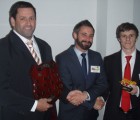
It says something about the vintage of the typical print person that the industry’s leading “junior” association welcomes anyone up to 40 years old. Print is an age-old process with an ageing workforce. The average workers are into their forties; the usual management types are into their fifties. Succession planning is one of the hot potatoes for many business owners; attracting young workers with fresh thinking is another. With this in mind, the industry would be wise to welcome any group dedicated to engaging young minds who will one day take the lead rope.
But there’s no two ways about it – it has been a difficult time for the Junior Printers Association of NSW (JPE). The demand for new skills and radical ways of thinking has never been greater, but one of the few organisations actively catering for these people has seen numbers dwindle and less than stellar turnouts to key events. But the organisation is not going down without a fight. It is undergoing a resurgence and has a new lease on life. It is building new connections and hunting down more recruits from a wider base.
The new marketing brochure explains: “While respecting its origins as an important resource for junior printing executives, the JPE of today has a wider vision and purpose. Put simply, everyone who is young and young at heart, is welcome to be part of JPE and help us, help young achievers in our industry reach their true business potential.”
The association got a chance to reveal this new energy at PrintEx11, thanks to a stand donated by show organisers – and long-time JPE supporters – the Graphic Arts Merchants Association of Australia (GAMAA) and the Printing Industries Association of Australia (PIAA).
JPE’s current president, Steven Gamble, whose day job is northern region sales manager for Böttcher, says: “One thing that was really good about appearing at PrintEx was we got to talk to people not just from NSW but from other states. They asked ‘what is JPE?’ and we were able to explain. So they asked ‘why don’t we have anything like that in our state?’
“It really resonated with me that this is something that is wanted and is needed but we have to get it out there,” he adds.
There used to be JPE-style associations in all states (except Tasmania). The body was founded in 1936 to help young printers build networks and learn management skills. Over time, it loosened its constitution to include a wider spread of printers, then suppliers. Fast-forward to the ’90s, and the various state associations were facing their biggest challenge. There was a standoff over the ‘junior’ moniker and a move to rebrand as the Printing Executives Association (PEA).
Industry stalwart and JPE president in 1991-92 Brian Haines remembers: “It had become a bone of contention to drop the word ‘junior’, because some committees felt it gave the wrong the image.”
All the other states did rebrand – and were soon consigned to the history books, with NSW the last man standing.
Sole survivor
The fact that JPE has survived in NSW is thanks to its affiliation with PIAA, which has provided admin and marketing support, as well as GAMAA, which has given financial backing, particularly for JPE’s annual conference. Steadfast members such as Avon Graphics’ David Konecke and Lindsay Yates Group managing director Paul Richardson have also helped keep the flame burning.
Today’s small but passionate JPE committee are keen to leave the past behind and focus on ensuring a prosperous future for this unique association. The current committee, including long-time member Franca Balsamo, who has devoted 14 years to keeping JPE going, can see a future beyond NSW and out into the wider facets of the industry. Fundamentally, they are moving away from just ‘printing’ and positioning the group as a body for young people in the wider graphics arts sphere.
It used to be essential that JPE members were drawn from PIAA stock. As the peak body’s membership fell over the years, JPE has looked beyond that association for new members. In fact, it hasn’t been compulsory for JPE members to be part of PIAA for quite some time. Informally, JPE has looked for membership from outside the peak body – something PIAA has no problems with. Gamble says JPE is considering changing their constitution at some point to make this official.
JPE’s aim is professional development. Unlike the PIAA or the Graphics Arts Services Association of Australia (GASAA), it does not represent businesses. Nor is it a technical body like the Lithographic Association of Australia (LIA).
“It was put together for young people to meet and learn and grow together. The whole promise of JPE is learning. You get to mix with both peers and also the hierarchy from other companies, the general managers and the like. You get a good spread of people to interact with and get different views. Former members take on a mentoring role and you learn skills with dealing with all level of management. You become more confident.”
The present committee are continuing to drive an agenda of openness to bring in new recruits. Gamble says JPE has moved away from any exclusive affiliation, but he is quick to point out that the group is not cutting ties with the peak body.
“JPE has had a long relationship with PIAA and they have been fantastic in supporting us. I recently had a meeting with [new PIAA chief executive] Bill Healey and he thinks it is a fantastic idea and something that should grow and he has pledged his support.”
But the group is now looking further afield to support. For instance, Gamble has met with Garry Knespal, executive officer of GASAA, who has stepped in to give renewed support to JPE and help it spread the message to a new audience.
When it comes to trade associations that have lost their support base and had to battle to find relevance, GASAA makes a good example. The trade body used to represent pre-press houses. As that segment of the market died off, the group was threatened with the worst ailment that can strike a trade organisation – irrelevance. GASAA has re-established itself as a forum for the digital print side of the market. There’s a lesson here for JPE, both in terms of attracting that side of the market, but also in re-imaging itself.
Knespal says: “One of the views JPE have taken in recent years is to broaden their appeal to people who are not PIAA members. We have picked up on that sentiment and said we are happy to support JPE as long as it non-aligned.”
The JPE agenda now is all about attracting new members. Its membership is currently split about 50:50 between printers and suppliers, and Gamble would like to see that ratio shift to better reflect the wider industry. With the exception of IPMG, which has been a big supporter of JPE through Offset Alpine, few of the other major printing groups are involved. Surely getting the likes of Blue Star, Geon and PMP on board would be an effective way to build the membership base. Gamble points out that the GASAA board includes management from Snap and Kwik Kopy.
“It’s only a small investment but what they get out of it is all these skills to use in everyday life and professional life,” says Gamble. He urges industry leaders to “look inside your business” to find candidates, but stresses: “We are struggling, we need to find these people, but it is not a charity. People who get involved with JPE will always take something away with them.”
Past Members
Kelly Bourke – Sales manager, SOS Print & Media
President, 2004-05
Highlight? Attending conference in WA and organising a very successful conference at Hunter Valley.
Skills gained? I gained confidence and also a network of contacts. All the people I know in the industry were involved with JPE.
Why join? Networking and exposure to many areas not covered in day-to-day work.”
David Murdoch – Estimating supervisor, Offset Alpine Printing
President, 1989-90
Highlights? Self-improvement nights, social activities, and visiting various companies.
Skills gained? From representing NSW at the various state conventions to creating and organising functions to public speaking.
Why join? It is the best thing you can do. Providing you get involved, especially in functions, it will be a highlight of your life in the industry.
Guy Marco – Director, Impress Printers
President, 1989-90
Skills gained? Public speaking: communication skills and professionalism.
Why join? It promotes a cooperation and self-help, where people can meet and not be judged on their abilities. You will find a lot of help.
Tom Lusch – Managing director, Platypus Graphics
QLD president, 1983
Highlights? I traveled to every mainland state capital of Australia, and would have notched up over 20 conventions. The friendships established have been invaluable.
Skills gained? These friends encouraged me to start Platypus, and backed me with credit terms, competitive costing and advice.
Why join? You can never have too many mates.Highlights? The camaraderie in the associations, even though we are fierce competitors. JPE recognises people for simply having a go.
Comment below to have your say on this story.
If you have a news story or tip-off, get in touch at editorial@sprinter.com.au.
Sign up to the Sprinter newsletter

